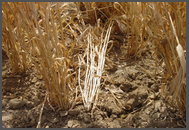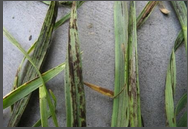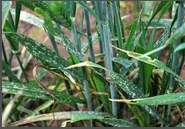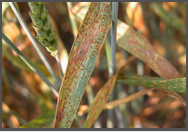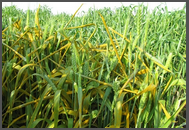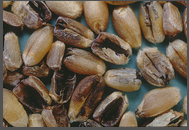Raj 1482: This variety has dark green color plant having 80-90cm of height. They have more pods, thick grains, shiny and shade color grains. It gives an average yield of 15-16 qtl/acre. The variety gets mature within 126-134 days. It is mainly used for making breads. It has 11-12% of protein content.
PBW 502: Suitable for irrigated areas. Plant height is about 90-100cm. Ready to harvest in 130-135 days. It is resistant to Karnal Bunt. It gives yield up to 18-20 qtl/acre.
PBW 550: Plant height is about 83-92cm. Ready to harvest in 128-135 days. It has thick grains which are golden yellow in color. The weight of 1000 grains is approximately 38gm. It gives yield of about 18-24 qtl/acre.
HD 2697: Plant height is about 83-91cm. Ready to harvest in 128-133 days. This variety is good for cultivation in heavy land. It has thick grains which are golden in color. Gives an average yield of about 18-24 qtl/acre.
Raj 6560: Suitable for irrigated areas. Plant height is about 90-100cm. Ready to harvest in 130-135 days. It gives yield upto 18-22 qtl/acre.
Raj 3077: This variety is also known as “Wonder Wheat”. The plant is having 115-118cm of height. It gives an average yield of 15-16 qtl/acre. The variety gets mature within 126-134 days. It is mainly used for making breads. It has 11-12.5% of protein content.
Raj 4079: Ready to harvest in 115-120 days. Plant height is about 75-80cm. Gives good result under normal as well as irrigated conditions. It shows resistance to lodging. It gives yield upto 19-21 qtl/acre. Grains are bold, medium size and hard. This variety can survive in warm climate of Rajasthan and gives high yield.
Raj 4037: The plant is having 83-95cm of height. It gives an average yield of 15-16 qtl/acre. The variety gets mature within 120 days. It is mainly used for making breads. It has 11-12% of protein content. The variety is resistant to black or stem rust.
Raj 4120: Ready to harvest in 110 to 124 days. Plant height is about 80-94cm. Gives good result under normal as well as irrigated conditions. Stem is strong thus it shows resistance to lodging. It gives yield upto 20-24 qtl/acre. This variety can survive in warm climate of Rajasthan and gives high yield.
DBW 17: Plant height is about 80-85cm. Ready to harvest in 130-132 days. It is resistant to Karnal Bunt. Stem is strong thus it shows resistance to lodging. Grains are bold, medium size and hard. Gives good result under normal as well as irrigated conditions. Gives yield upto 16-20 qtl/acre.
Raj 4238: Ready to harvest in 115-120 days. Plant height is about 82-86cm, stem is strong enough and prevent crop from lodging. It is resistant to Karnal Bunt. Grains are of medium size and gives yield upto 16-20 qtl/acre.
WH 1080: Ready to harvest in 127-133 days. Plant height is about 85-101cm. Under irrigated condition gives yield upto 16-18 qtl/acre. Its grains are amber, medium bold and hard.
PBW 175: Ready to harvest in 130-132 days. Plant height is about 90-105cm. Its grains are amber, medium bold and hard. Under irrigated conditions, gives yield upto 15-16 qtl/acre.
CCNNRVOI(Raj Molya Rodhak-1): It is suitable for timely sown irrigated conditions. Plant height is about 84cm. Grains are amber color, semi hard and round shape. Ready to harvest in 120-125 days. It gives yield upto 15-18 qtl/acre. This variety is popular in cereal cyst nematodes infected areas.
Late sown varieties:
Raj 3765: The variety can be sown third week of December to mid-January. Plant height is about 85-95cm. This variety gets ready to harvest within 120 days. It gives an average yield of 16-20 qtl/acre.
Raj 3777: The variety gets mature in 90-95 days. The sowing time for this variety is in mid-January. It gives an average yield of 14-16 qtl/acre.
Sandy soil varieties:
It requires less water for their growth.
C 306: The variety is used in barren land and it requires less irrigation. Plant has long height. It has medium sized grains and is of golden color. It gives an average yield of 14-16 qtl/acre.
P.B.W. 299: Plant height is 95cm. The variety gets mature in 150-160 days and the variety is sown earlier. It gives an average yield of 16-18 qtl/acre. Along with these varieties PBW 396 and WH 147 is also cultivated.
Saline soil varieties: Use varieties such as Raj 3077, K.R.L 1-4 and WH 157 for saline areas which will give good yield.
Other state varieties:
RAJ-3765: It matures in 120-125 days. Heat tolerant and suitable for zero tillage, Susceptible to brown rust, moderately susceptible to stripe rust and Karnal bunt. The yield is near about 21 qtl/ acre.
UP-2338: It matures in 125-130 days. It is susceptible to leaf rust and moderately susceptible to stripe rust. Susceptible to Karnal bunt and tolerant to blight. The yield is near about 21 qtl/acre.
UP-2328: It matures in 130-135 days. Ear heads are white hard, sarbati colour & medium size grains. It is suitable for irrigated areas. The yield is near about 20-22 qtl/acre.
Sonalika: Early maturing single dwarf wheat with wide adaptation and attractive amber grains. It is suitable for late sowing and resistant to rusts.
Kalyansona: A double dwarf wheat with wide adaptation recommended for cultivation all over India. This variety is very vulnerable to rust. Therefore, It is advisable to grow it only in rust free regions.
UP-(368): High yielding variety developed by Pantnagar. It is resistant to rust and Karnal bunt.
WL-(711): It is single dwarf, high yielding and medium maturing variety. It is moderately susceptible to powdery mildew and Karnal bunt.
UP-(319): It is triple dwarf wheat with high level of rust resistance. To avoid losses to shattering, it should be harvested at appropriate time.
Late varieties of wheat - HD-2851, HD-2932, RAJ-3765, PBW-373, UP-2338, WH-306, 1025
PBW 590: It is grown in all areas of Punjab. It gets ready for harvesting within 128 days. It is resistant to yellow and brown rusts diseases. It has an average height of 80cm.
PBW 509: It is grown in all areas of Punjab except sub-mountainous region. It gets ready for harvesting within 130 days. It is resistant to yellow and brown rusts diseases. It has an average height of 85cm.
PBW 373: It is grown in all areas of Punjab. It gets ready for harvesting within 140 days. It is resistant to brown rusts diseases. It has an average height of 90cm.

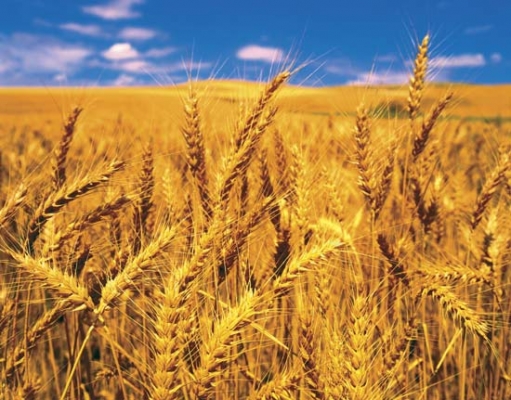



.png)
